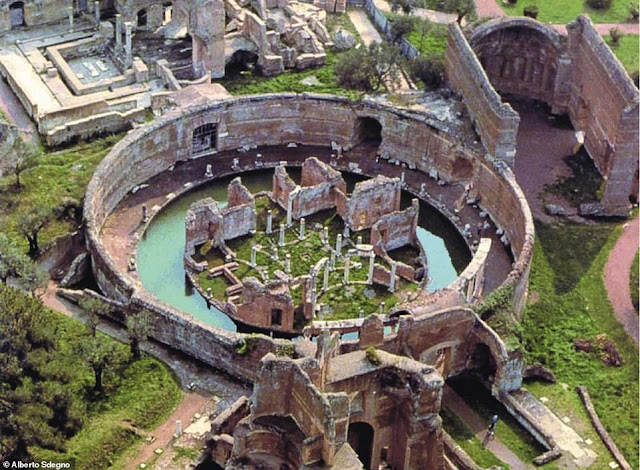Hadrian (76-138 CE) is at the middle of the sequence called "the Five Good Emperors of Rome." A proponent of Greek art and culture, he took a Greek lover, Antinous, and was made an honorary citizen of Athens. Hadrian refused to expand the boundaries of the Empire preferring to consolidate and defend what he inherited. He was a builder of many monuments and public improvements, even going so far as to help design them. Like just about any Roman emperor, however, he had a brutal side. Hadrian had four prominent Senators executed upon his accession for unclear reasons. He was rumored to have poisoned his wife, for whom he had no use, and he brutally repressed any opposition or rebellion. A revolt in Roman Judaea lasted years and resulted in the death of over half a million Jews, with many others being enslaved. Still, Hadrian left quite a legacy.
I took this photo of the Pantheon on a visit to Rome in 1998. Hadrian rebuilt and enlarged this incredible edifice with its amazing concrete dome and stone brought from all over the Empire. In an unusual stroke of modesty, he left the name of Agrippa prominently displayed despite the fact that the new version bore little resemblance to the one built by Agrippa.
This statue shows a nude Hadrian as Mars with Venus.
Above is the Maritime Theater, which is not a theater at all,
but Hadrian's private retreat inside his massive villa outside Rome.
I freely confess to having had a crush on Hadrian since I saw this bust in the British Museum.
This is Hadrian's Mausoleum which was later repurposed by the Popes as a fortress
they called Castell Sant'Angelo. For me, the original interior sections were far
more interesting than all the Papal trappings built on the top.







If Hadrian is regarded as one of the five good emperors, I'd like to see the worst. That said, his lifetime fell into one of those periods when Hellenism regained social currency and a Roman was not considered educated unless he had mastered Greek - in much the same way as an Englishman of the 18th and 19th centuries was regarded as a country hick if he couldn't speak the lingua franca of his age, French. Such was the Greek Revival, Arrian of Nicomedia, a contemporary of Hadrian, wrote his Ἀλεξάνδρου Ἀνάβασις (Alexándrou Anábasis), a seven-volume work that sequentially recounts the campaigns of Alexander the Great between 336 and 323 BCE, in the style of the Greek historian Xenophon. Other authors followed suit. Alexander was the stereotypical general and conqueror with whom the dictator perpetuo (dictator-for-life) Julius Caesar and all later emperors would compare themselves.
ReplyDeleteAll Roman emperors were depicted in a ceremonial style. Fashions changed over the generations - the Romans are in fact to be held responsible for the mullet hairstyle - and in his numerous depictions, Hadrian's beard is a conscious and deliberate reference to Greek sculpture which depicted beards in such a way. In fact, Hadrian was one of the first bearded Romans for several generations.
As for that particular bust, Jerry, do check on Amazon. Apparently, one of the British Museum's directors has recently been arrested for pillaging the Museum over a number of years and selling on his ill gotten gains. Quite a scandal...
We do have to take the depiction of Roman emperors with a barrel of salt. An unflattering rendition could be career ending . . . or worse. Yes, the British Museum has apparently had shockingly lax security arrangements. It had to be an eye opener when someone recognized a piece from there on eBay.
DeleteMy own thinking is that Hadrian was very clever to retain the porch of Agrippa's old standard rectangular temple, in order to guarantee the shock of his great new (virtually) spherical Pantheon. It certainly retains its amazing ability to shock and dazzle anyone who walks inside.
ReplyDeleteI agree. The man was undoubtedly very intelligent and very aware of the value of creating impact with the public. He also hired some very good people to carry out the practicalities of his ideas.
Delete